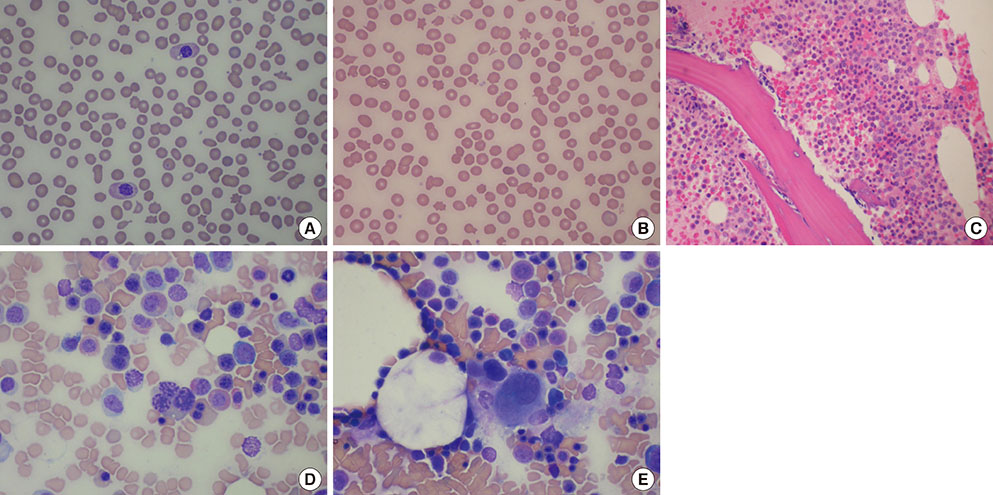Lab Med Online.
2016 Jan;6(1):41-44. 10.3343/lmo.2016.6.1.41.
A Case of Myelodysplastic Syndrome Characterized by Hemolytic Anemia at Presentation
- Affiliations
-
- 1Department of Laboratory Medicine, Yeungnam University College of Medicine, Daegu, Korea. kimyk@yu.ac.kr
- KMID: 2312291
- DOI: http://doi.org/10.3343/lmo.2016.6.1.41
Abstract
- A man aged 78 yr with no history of chemotherapy or toxic exposure presented with a history of dyspnea and intermittent red urine for 3 months and several years, respectively. Hematologic data at admission were as follows: hemoglobin, 65 g/L; white blood cell count, 4.05x109/L; platelet count, 96x109/L; and reticulocyte count, 10.9%. A peripheral blood smear revealed polychromasia, nucleated red blood cells, and neutrophils with a non-lobulated nucleus. The bone marrow was hypercellular and exhibited an increase in erythroid precursors with trilineage dysplasia and our findings were suggestive of refractory cytopenia with multilineage dysplasia (RCMD). Karyotype of bone marrow cells was as follows: 45,XY,der(9;17)(p10;q10),add(18)(q11.2)[10]/45,idem,del(3)(q21)[10]. Other laboratory findings showed decreased serum haptoglobin, increased lactate dehydrogenase, and increased indirect bilirubin levels. Moreover, results of the direct/indirect antiglobulin test (Coombs' test) and paroxysmal nocturnal hemoglobinuria analysis with CD55, CD59, fluorescent aerolysin (FLAER), and CD24 were negative. Cold agglutinin and Donath-Landsteiner antibodies were not detected. This is a case of myelodysplastic syndrome (MDS) associated with hemolytic anemia and complex chromosomal abnormalities at presentation.
Keyword
MeSH Terms
-
Anemia, Hemolytic*
Antibodies
Bilirubin
Bone Marrow
Bone Marrow Cells
Chromosome Aberrations
Coombs Test
Drug Therapy
Dyspnea
Erythrocytes
Haptoglobins
Hemoglobinuria, Paroxysmal
Karyotype
L-Lactate Dehydrogenase
Leukocyte Count
Myelodysplastic Syndromes*
Neutrophils
Platelet Count
Reticulocyte Count
Antibodies
Bilirubin
Haptoglobins
L-Lactate Dehydrogenase
Figure
Reference
-
1. Gologan R. Mixed myelodysplastic syndrome associated with beta-thalassemia intermedia. Leuk Res. 2010; 34:e221–e223.2. Herbaux C, Badens C, Guidez S, Lacoste C, Maboudou P, Rose C. A new ATRX mutation in a patient with acquired α-thalassemia myelodysplastic syndrome. Hemoglobin. 2012; 36:581–585.
Article3. Yarali N, Duru F, Sipahi T, Kara A, Teziç T. Parvovirus B19 infection reminiscent of myelodysplastic syndrome in three children with chronic hemolytic anemia. Pediatr Hematol Oncol. 2000; 17:475–482.
Article4. Shimamoto T, Ohyashiki K. Immunosuppressive treatments for myelodysplastic syndromes. Leuk Lymphoma. 2003; 44:593–604.
Article5. Enright H, Jacob HS, Vercellotti G, Howe R, Belzer M, Miller W. Paraneoplastic autoimmune phenomena in patients with myelodysplastic syndromes: response to immunosuppressive therapy. Br J Haematol. 1995; 91:403–408.
Article6. Parmentier S, Schetelig J, Lorenz K, Kramer M, Ireland R, Schuler U, et al. Assessment of dysplastic hematopoiesis: lessons from healthy bone marrow donors. Haematologica. 2012; 97:723–730.
Article7. Novaretti MC, Sopelete CR, Velloso ER, Rosa MF, Dorlhiac-Llacer PE, Chamone DA. Immunohematological findings in myelodysplastic syndrome. Acta Haematol. 2001; 105:1–6.
Article8. Barcellini W, Zaninoni A, Imperiali FG, Boschetti C, Colombi M, Iurlo A, et al. Anti-erythroblast autoimmunity in early myelodysplastic syndromes. Haematologica. 2007; 92:19–26.
Article9. Voulgarelis M, Giannouli S, Ritis K, Tzioufas AG. Myelodysplasia-associated autoimmunity: clinical and pathophysiologic concepts. Eur J Clin Invest. 2004; 34:690–700.
Article10. Lin JT, Wang WS, Yen CC, Chiou TJ, Liu JH, Hsiao LT, et al. Myelodysplastic syndrome complicated by autoimmune hemolytic anemia: remission of refractory anemia following mycophenolate mofetil. Ann Hematol. 2002; 81:723–726.
Article11. Oren H, Uçar C, Gülen H, Duman M, Irken G. Autoimmune hemolytic anemia occurring with myelodysplastic syndrome: report of a pediatric case and review of the literature. Ann Hematol. 2001; 80:540–542.
Article12. Tamura S, Konya H, Miyazaki E, Inoue N, Okamoto T, Takemoto Y, et al. Coombs negative autoimmune hemolytic anemia in a patient with myelodysplastic syndrome. Rinsho Ketsueki. 1991; 32:132–136.13. Shim KY, Roh MO, Kim HJ, Bae SB, Kim CK, Lee KT, et al. Autoimmune hemolytic anemia in myelodysplastic syndrome. Korean J Hematol. 2006; 41:317–320.
Article14. Girodon F, Favre B, Carli PM, Nash N, Desbiolles N, Tatou E, et al. Minor dysplastic changes are frequently observed in the bone marrow aspirate in elderly patients without haematological disease. Clin Lab Haematol. 2001; 23:297–300.
Article15. Bowen D, Culligan D, Jowitt S, Kelsey S, Mufti G, Oscier D, et al. Guidelines for the diagnosis and therapy of adult myelodysplastic syndromes. Br J Haematol. 2003; 120:187–200.
Article16. Adès L, Itzykson R, Fenaux P. Myelodysplastic syndromes. Lancet. 2014; 383:2239–2252.
Article17. Antic D, Impera L, Fekete MD, Djordjevic V, Storlazzi CT, Elezovic I. Novel chromosomal translocation (17;22)(q12;q12) in a case of myelodysplastic syndrome characterized with signs of hemolytic anemia at presentation. Gene. 2012; 493:161–164.
Article
- Full Text Links
- Actions
-
Cited
- CITED
-
- Close
- Share
- Similar articles
-
- Autoimmune Hemolytic Anemia in Myelodysplastic Syndrome
- Myelodysplastic Syndrome with Delayed Maturation of Reticulocytes: A Report of Three Cases
- A Case of Microangiopathic Hemolytic Anemia after Myxoma Excision and Mitral Valve Repair Presenting as Hemolytic Uremic Syndrome
- A Case of Immune Hemolytic Anemia due to Autoantibodies Against C and e Antigens in a Patient with Paroxysmal Nocturnal Hemoglobinuria and Myelodysplastic Syndrome
- A Case of Autoimmune Hemolytic Anemia after Fludarabine Treatment in Waldenstrom Macroglobulinemia



